
17 minute read
Snow toys add a twist to the
Snow toys add a twist to the f luffy stuff
Leslie Foster
Advertisement
In snow time, some people are hunkering down, looking for the rock salt, and lighting a fire. Others can’t wait to get outside to enjoy the fresh, white, cold blanket over our part of the world. For this happy group, fun is everywhere, including the back yard, so we’ve looked up some “tools” to make bombing down the hill, fort-building, and snowball fights even better.
Think safety: Wear a helmet for downhill fun, stay away from roads or snowmobile trails, and pick hills with no trees or rocks.
xThe lightweight Snow Block Maker makes building forts more fun than ever. Its uniform bricks
xIf you’re under attack, there’s nothing like speed to replenish your pile of snowballs. The Snowball Maker is durable plastic, and easy enough to use for little kids and cool enough for the biggest kids. It makes perfect, soft, round snowballs … great for throwing, an essential snowball war tool.

make stacking a breeze. Just pack with snow and dump. With the right snow conditions, you’ll be surrounded by walls in no time.
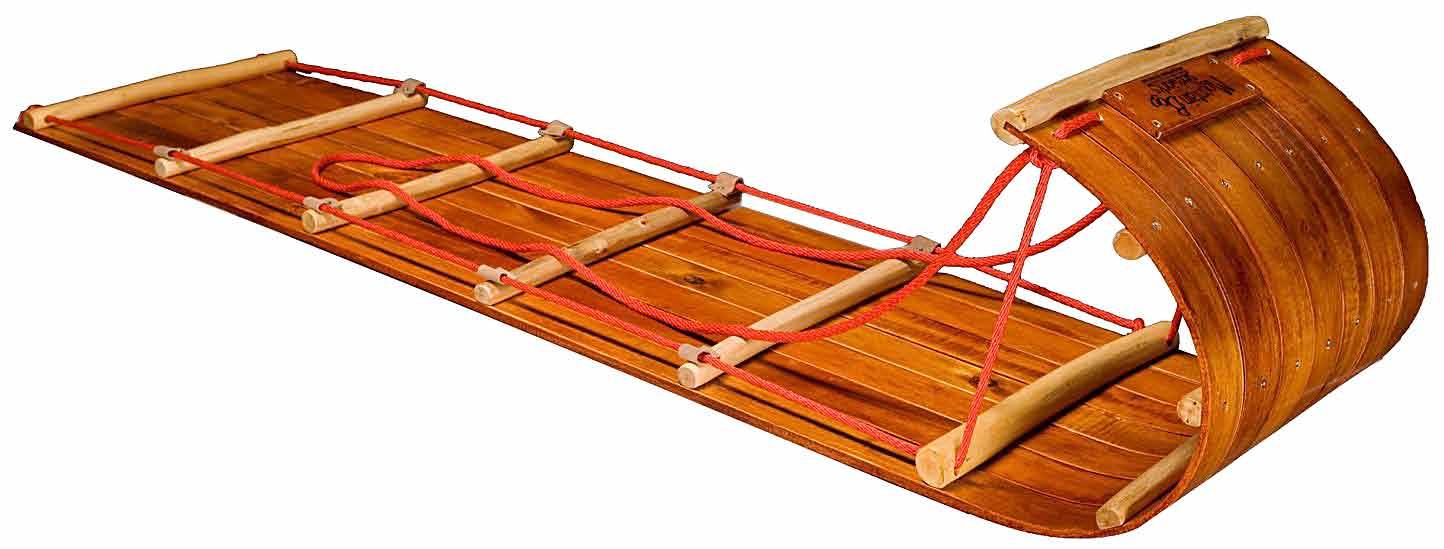

For anyone with artistic urges, snow can be a marvelous canvas. Crayola Washable Markers are great for decorating snowmen. Spray bottles filled with KoolAid easily add colour to larger surfaces. x
The Yardboard is a super cool slider that lets you go booting down hills with no other special equipment required. It works on dirt, grass or snow and is virtually indestructible. Recommended for ages six and up.

x
Hand-crafted, vintage-style to
boggans made by Mountain Boggans feature steam-bent, knot-free basswood planks and handcarved willow crosspieces. Gorgeous and functional, the sleds curl at the front large enough for adult feet. Each model has an extra-long rope for easy towing. This one will last for generations. Available in four-foot (1.2 m), sixfoot (1.8m) and eight-foot (2.4 m) lengths. If you have wee ones, check out their vintage-style baby sleds too. x

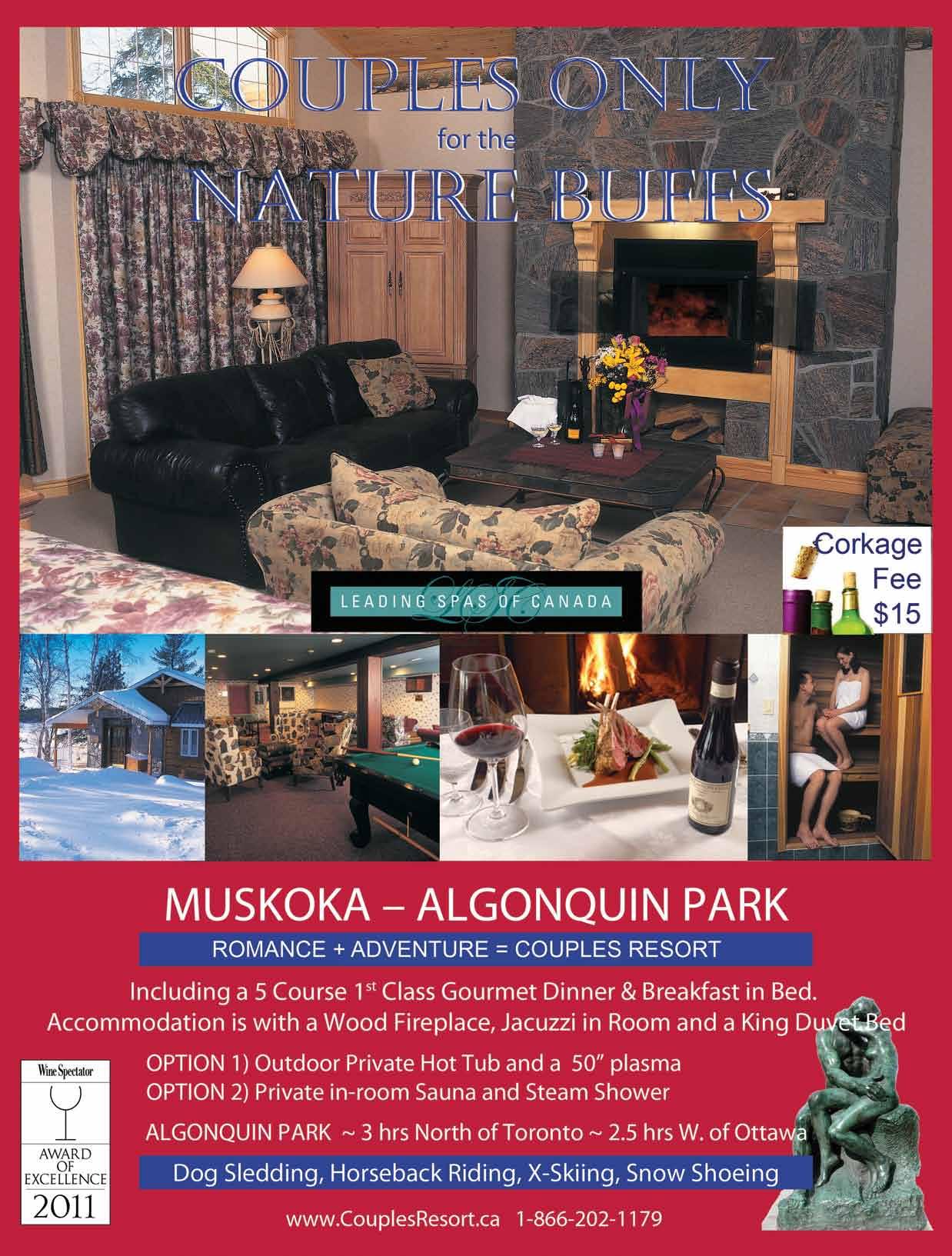
TIMMINS the great outdoors and more!
this year... eliminate the cabin fever blues
SNOW, it’s our favorite four letter word. Every Year we get piles of it. How many inches you ask? Actually we measure our snow in feet, and most winter’s it’s so high we prefer to share it rather than shovel it. We also like to make things with it, like trails and tracks and moguls. We’ve discovered that it’s even good for holding up your ice- fishing rod just right. You might even spot the odd igloo, although we recommend one of our more comfortable hotel rooms, or cozy resorts. Don’t look to the Farmer’s Almanac for ideal snow destinations this winter, just head north to Timmins because here we know snow and the conditions are usually perfect for all your winter outdoor recreational pursuits. Here you can actually feel the warmth of our Northern Ontario winter. At the end of a beautiful, crisp, winter day we’ll warm your heart and soul as you warm your toes. For a true taste of wilderness hospitality, there are well appointed rustic resorts and lodges, full service hotels and motels and well appointed B&B’s at your service. Making your stay even more pleasant is a wide variety of dining options, from casual, to fine dining. With regular service by Porter Airlines, Air Canada and Bear Skin Air getting here has never been easier.
Winter Experiences: The residents of the City of Timmins enjoy the best of all worlds. Our great outdoors combined with a lifestyle and quality of life often the envy of many other jurisdictions, makes this city a perfect place to be all year round. Timmins is home to hundreds of lakes and rivers that are just waiting to be discovered, even in winter. We are passionate about the great outdoors and the many adventures and activities that are never more than a stones throw away. With the clean, crisp air and the glistening snow of winter, it’s no wonder that so many families living here have discovered the joys of ice fishing on the many frozen lakes and waterways usually teeming with perch, whitefish, trout, northern pike and of course, the tasty, succulent pickerel. The sight of many multi colored fishing huts popping up on many of our area lakes is testament to our love of the great outdoors. Located only 3 km from downtown Timmins, the Porcupine Ski Runners is one of the largest cross country ski clubs in Canada. Boasting a new $1.7 million dollar Xstrata Copper

Chalet and approximately 30 kilometers of scenic and groomed trails, some fully illuminated for night skiing, you can enjoy an incredible experience while sharing the great outdoors with lynx, moose, weasels, snow hares, partridge, and a snowy owl. For the avid hiker the Porcupine Ski Runners is truly a paradise with a fully signed snowshoe trail system designed to challenge anyone from experienced to novice while providing all ages with the ultimate workout. For your convenience, locker rentals and snowshoe rentals are available The Porcupine Ski Runners is truly a world class facility! For more information, on rates or upcoming activities visit www.porcupineskirunners.com The Kamiskotia Ski Resort has been a part of this community for over 40 years and has become an important winter attraction for the City of Timmins. Its northerly location gives it a nearly six-month season with an average snowfall of 340 cm (134 in.). Located on Mt. Jameson, an extinct volcano, Kamiskotia provides a 122-metre vertical, proving to be the 3rd highest vertical out of 8 resorts in Northern Ontario. With 12 runs over 68 acres of land ranging from easy to extremely difficult, this resort can be challenging for any level of skiing and snowboarding. Kamiskotia has a piece of winter for everyone and anyone with any level of capability. The Venture Center Tube Park, equipped with night lights and a rope lift is a great way to hit the hill with the whole family. With 2 cross country skiing loops, a state of the art chalet and bar, changing area with lockers and much more this makes our resort one of the top resorts in Ontario. To learn more about their facilities and activities please visit www.kamiskotia.com Timmins is the ultimate destination for a snowmobile vacation. Here you will enjoy spectacular scenery, where you will log hundreds of kilometers on our network of uncongested, perfectly groomed trails. With an average annual snowfall of close to 10 feet, this snowmobile destination is “best in class”. Access our many shops, hotels, restaurants, gas stations and local attractions such as the Cedar Meadows Wilderness Park, (where you will be up close and personal with the Majestic Canadian Moose), from the comfort of your sled via our snowmobile friendly network of routes.
For more information, contact us at 1-800-387-8466 or visit www.tourismtimmins.com
warm up to winter
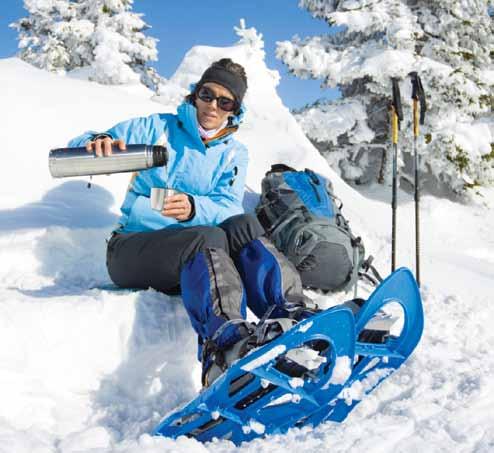
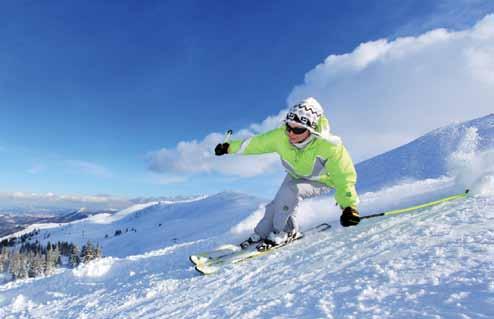
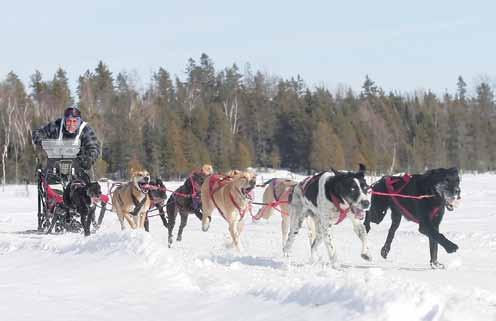

We will be at the following outdoor adventure shows: Toronto | February 21-23 Ottawa | March 15-16

For your free colour travel guide call 1-800-387-8466 or download a copy at www.tourismtimmins.com

Addicted to the Arctic
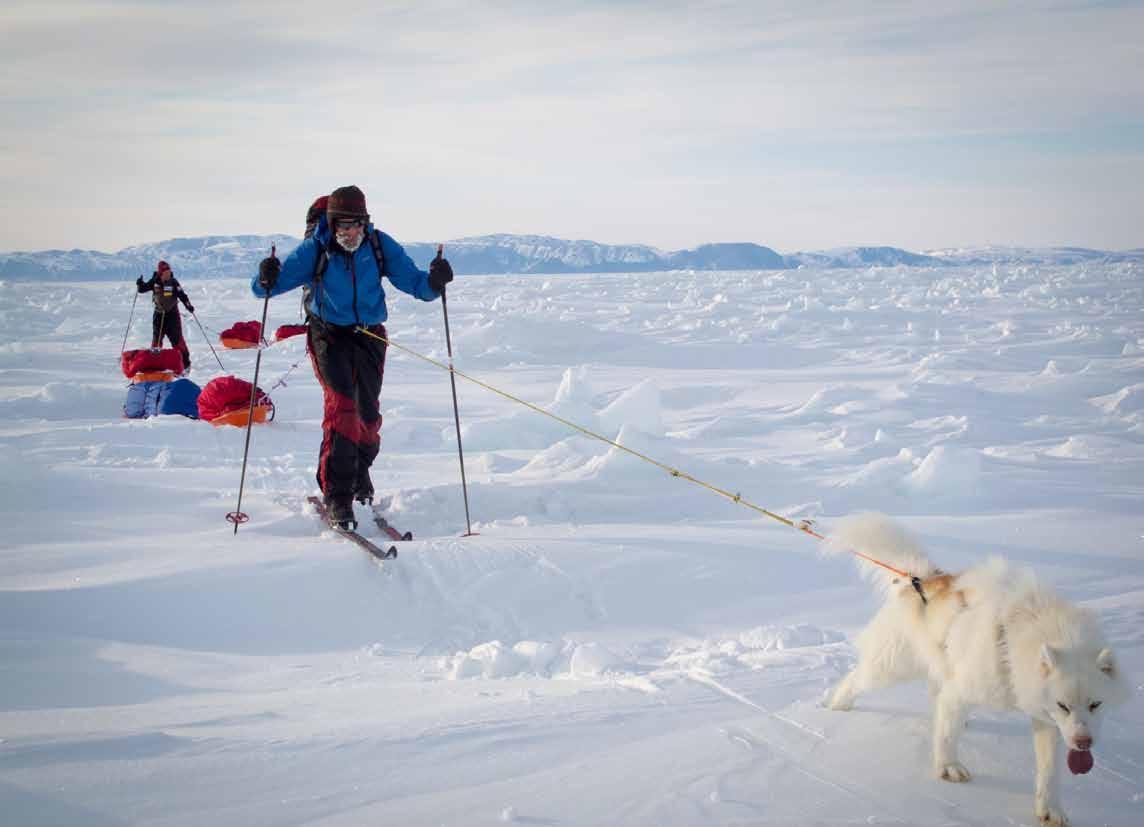
Hugh Dale-Harris skijoring with dog Larry and pulling a two pulks on Ellesmere Island.
Four men, four dogs, 62 days across Ellesmere Island
Sheila Ascroft
Adventure comes in all sizes, but Ottawa resident Hugh DaleHarris prefers the really big ones. Especially big Arctic ones.
“I’ve definitely caught the ‘Arctic Bug’,” he says.
He caught the bug’s “skijoring” version, the kind where an adventurer on cross-country skis teams up with a trusted and very hardworking dog to haul 100 kilograms-plus of gear across snow and ice.
In March, with his canine partner and three other man-dog teams, Dale-Harris traversed 985 kilometres of Ellesmere Island on skis.
“Ellesmere is a magical place,” said DaleHarris, 42. “It’s a precious land and not many people know about it or visit there because it’s so isolated.”
With American John Huston, Norwegian Tobias Thorleifsson, and South African filmmaker Kyle O’Donoghue, they retraced the century-old route of Norwegian explorer Otto Sverdrup. They called it the New Land Expedition.
When I first met him last winter, this tall, lean 42-year-old with an easy-going manner was wearing a harness like a donkey and pulling tires along bare pavement in Ottawa East. First, it was two tires. Then three, sometimes with one of his children sitting on the rims. He maxed out at five after months of “land” training, some of it actually on snow and ice. Ironically, the weather up north was mostly warmer than expected and made for great skijoring.
It wasn’t all work. The explorers walked the land, filming and seeing (and being seen) by wildlife: more than 60 wolf sightings (one stole food from their unoccupied tent), 96 muskox, 116 Arctic hares (three from a nearby den came within spitting distance), two polar bears, 16 seals and five Arctic fox.
Dale-Harris is no newcomer to this kind of thing. He co-led the North Pole 2005 worldrecord dogsled expedition (36 days, 750 kilometres) and was part of a 4,000-kilometre dogsled project from Yellowknife to Pond Inlet in 2004.
“If you are passionate about something,” he says, you end up in “some of the most stun
Awesome close-up of a muskox herd of about 12 animals spotted up on a hill
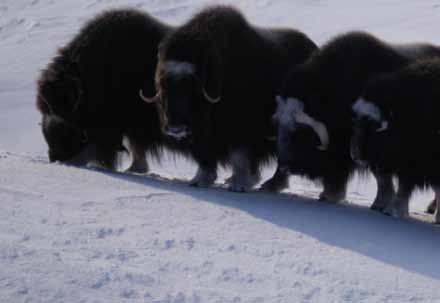
ning and awe-inspiring places in this amazing country.”
The team’s Ellesmere route celebrated an expedition that mapped over 200,000 square kilometres of Canada’s high Arctic more than 100 years ago. Norwegian Otto Sverdrup led a trek that overwintered on Elles- mere Island in 1898–1902. He came home with thousands of plant samples, 2,000 glass containers of smaller animals, quantities of plankton, rock and fossils, and data on ice, local temperatures, and the Earth’s magnetism that took years to process and be published in
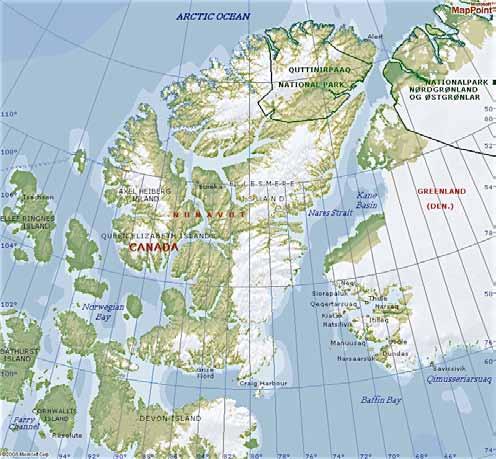
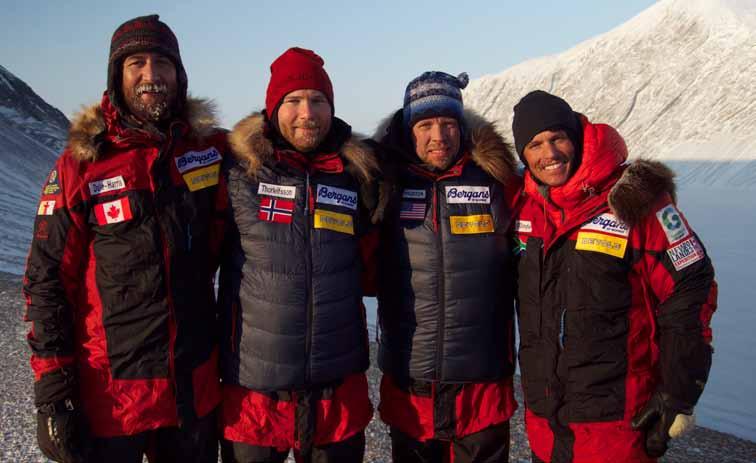
Expeditioners: (from left): Hugh Dale-Harris (Canada), Tobias Thorleifsson (Norway), John Huston (USA), and Kyle O’Donoghue (South Africa), expedition videographer. | Map of the route.
Skijoring down the smooth ice of a river on another beautiful day int he Arctic.
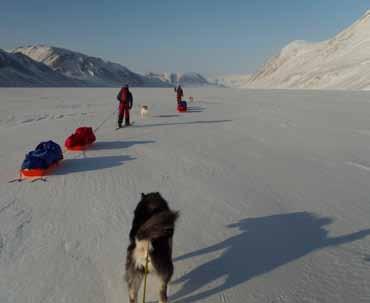
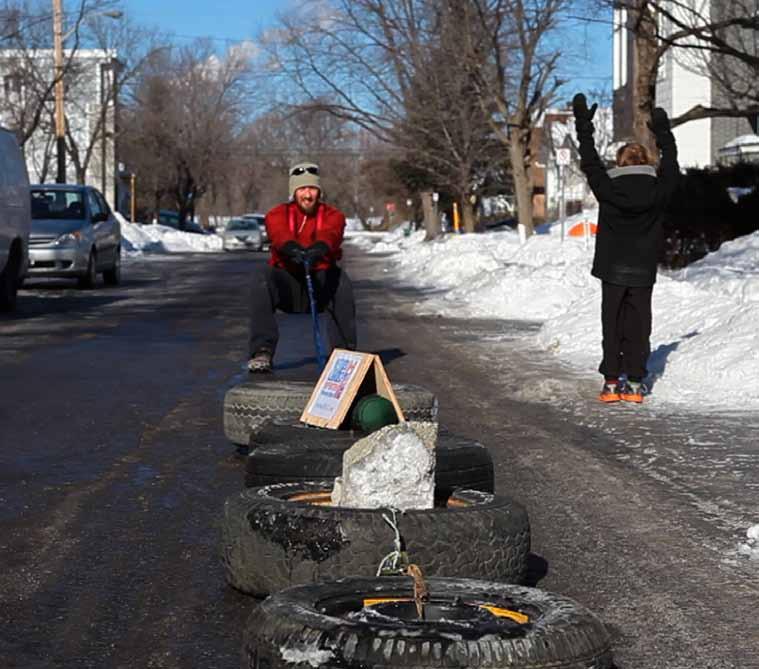
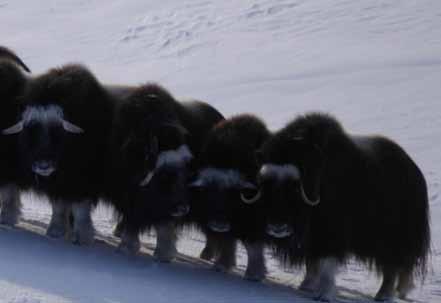
five volumes.
Dale-Harris says that despite that expedition’s scientific importance, it’s not well known.
His group wanted “to shed light on this incredible expedition of humble, loyal, highly skilled people who quietly went about their ways, living and thriving in sometimes truly harsh conditions.”
Dale-Harris shrugs off the weather. “I love the cold. I grew up in Ottawa, but I’ve learned that it is about the farthest place south that I would live.” Sleeping in the cold was
Pulling tires (loaded with concrete chunks) as a dryland training method for the expedition.
not much of a problem either because soon enough the group had 24-hour sunlight.
“With the sun always hitting the tent, and no tree shade, the tent can warm up quite a bit. In the last few weeks, we actually tried to beat the heat by sleeping in the day and travelling at “night.”
The cooler option was better for the dogs too. (The four well-furred powerhouses were Larry, Elle, Napu and Axel). “Travelling at night with the sun low and at our backs was some of the most beautiful skijoring I’ve done. The light illuminated the landscape and ice around us in a way that I will never forget.”
Dale-Harris was primed for a trip such as this. For years he ran dog teams at Outward Bound, north of Thunder Bay and then had his own team. He says the dogs added much to the expedition besides muscle power.
Teammate John Huston says the dogs “were our teammates and they knew it. They signaled this with their boisterous hooting and howling sessions (led by bandleader Elle who has a very impressive vocal range) that sounded off every morning when we started packing the sleds. They were our eager sled
100 weekly yoga classes including yoga tailored to fitness enthusiasts • 4 yoga studios • weekly workshops • yoga teacher training
Offering YOga fOr everYOne Come on up to our Place! from beginner to advanced
NEW LODGE 9 LOG CABINS (SOME WITH JACUZZIS) P RIVATE BATHS • SATELLITE TV
HDL • FIREPLACES Luxury Retreat on the Madawaska River. Welcome to the lodge where everyone feels like family. Exceptional breakfasts and dinners included. 30 km of skating trails, 30 km of back country trails and 30 km of groomed trails, all for your An interview with Lael Morgan, executive director of the Ottawa Sport and Social Club Algonquin discovery. Tell us about your club from $ pp with Meals, Limited Winter Nights from $57pp with Meals. A Couples Retreat.
Yoga improves stamina, strength, flexibility, focus, endurance and reduces injury.
The Ottawa Sport and Social Club offers co-ed recreational sport leagues, tournaments and social climb higher breathe fuller run farther gatherings throughout the year for stretch deeper Ride faster do more yoga anyone 19 or older. We provide an Book on-line now www.adventurelodge.com or call 1-888-327-3403 opportunity for adults, regardless of ability, to try a new sport or get 342 Gladstone Ave, between Bank & O’Connor Whitney-Algonquin Park 613.234.7974 • www.ottawayoga.com involved in an old favourite with
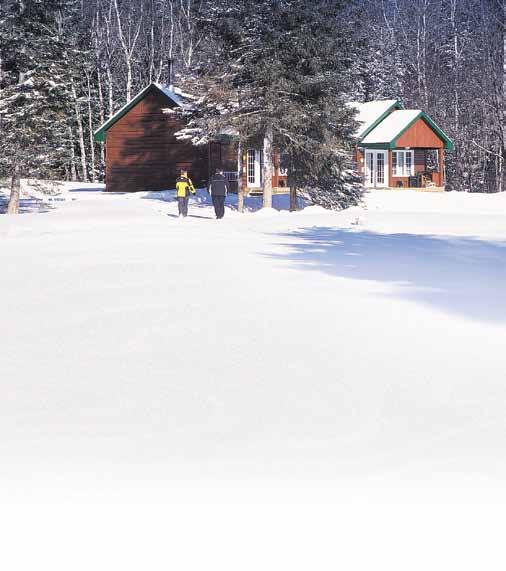
www.ottawaoutdoors.ca Get there in style
Rent a limo for your next outing!

ottawa outdoors
Sens Games Girls Getaway Family Fun

Ski Trips


Graduations
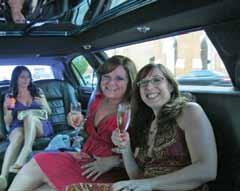

Anniversaries
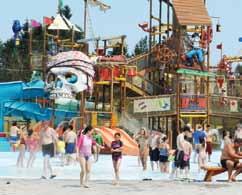

Limos for couples and groups from 2 to 26ppl
Contact Robinson Limousine Tel: (613) 833-1386 Cell: (613) 286-0047 info@robinsonlimo.com RobinsonLimo.com
Enjoying a quiet moment with some fearless Arctic hares.
pulling partners, snack break companions, endless sources of conversation, subjects of our silly songs and sillier banter, wildlife warning signals, and an endearing, hilarious social presence.”
And their muscle was impressive. “Each man-dog combo pulled pulks (sleds) with
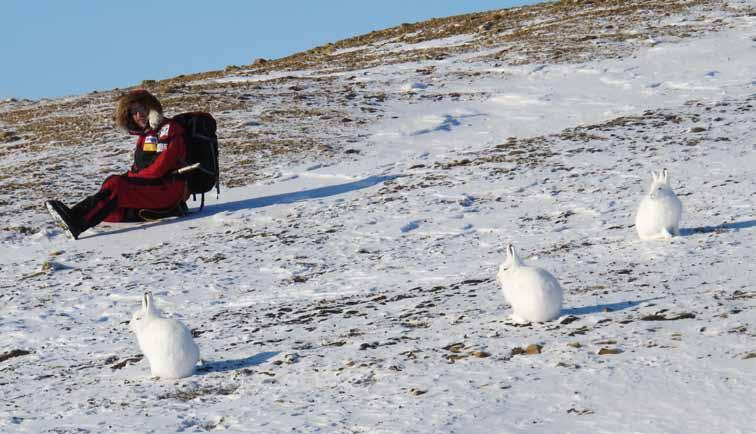
about 250 pounds (just over 100 kg) of equipment at least 20 kilometres per day,” Dale-Harris says.
So men and dogs needed a lot of food. Dale-Harris was especially fond of en-route snacks of deep-fried bacon.
Breakfast ‘soup’ was whole milk powder, butter, olive oil, and sugar mixed with a freeze-dried packaged breakfast cereal. “We also made our own 630-calorie energy bars with donated Camino chocolate, almond butter, butter, ground mixed nuts, coconut oil, and flavouring. We ate at least two per day and never tired of them! Dinner was usually a freeze-dried entree with extra olive oil, butter, and hot chocolate and potato chips.”
With two Norwegian clothing sponsors they stayed comfortable, warm and relatively non-stinky.
“When we got to the Eureka weather station, after 30 days of trekking, the people said we were the best smelling expedition to arrive!” Dale-Harris says with a laugh.
Despite ice travel being relatively fast and easy, “it was more interesting to go overland … little hikes and skis onto the land after we pitched the tent or on our days off.”
Was there danger? Well, to hear him tell it, there was no worry about polar bears or wolves, but a fire from spilled stove fuel in the tent “would have been horrendous.” It didn’t happen.
The team travelled through the dense polar bear populations on Bjorn (Norwegian for “bear”) Peninsula, and had two encounters
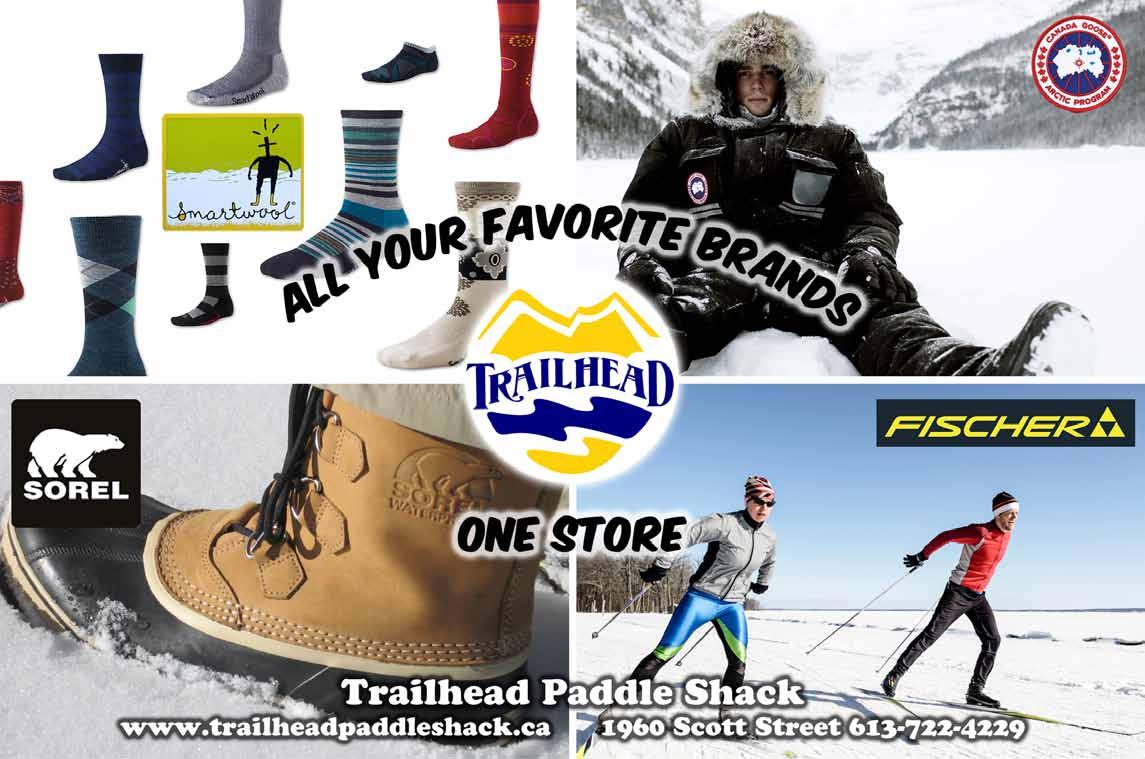
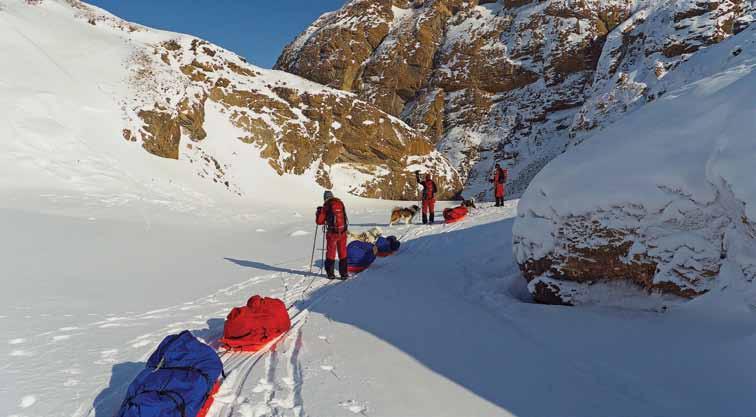
Sixty-two days of travelling on skis in a pristine land where the weather only turned stormy once.
with the locals. Both times, the bears walked around downwind, sniffing and standing on hind legs for a better look, but then “decided there were better meal options” and left to hunt seals.
A pack of eight wolves also checked out the camp one day – from about 200 metres away.
“They looked like ice chunks!” says Dale-Harris. “They just seemed to appear out of nowhere, howled and our dogs responded. They sniffed around a little bit but stayed their distance. Then they vanished into the Arctic again. They’re amazingly camouflaged.”
While delights abounded there was one disappointment. The men believe they located a Sverdrup cairn on Ellesmere’s north coast (working from details in Sverdrup’s account of the trip in a book titled New Land, and his diary), but nothing at the site proved it was his. Robert Peary left a note in this cairn around 1905, but did he build it?
“Connecting our expedition to Sverdrup’s was a really big deal,” says Dale-Harris, keenly aware of the comparison of “reading about an area or an experience in his books, and then seeing it for ourselves. We could so easily imagine what it would have been like for them.”
The fossilized forest on Axle Heiberg Island is high on his delight list – remnants of a forest 40 million years old. “For days before reaching it, we were finding fossilized wood in the river.” At the site itself, “there were still also large chunks of stumps and branches in decent condition. Pretty amazing!”
Asked about the future, Dale Harris mentioned Nunavut’s Skraeling Point with its tent rings and food caches thousands of years old. “There are so many magical places not far from Eureka, and Grise Fiord would be interesting….”
But for now, he looks back to “the magical kingdom of Ellesmere. Stunning beauty every day, and changing too.”
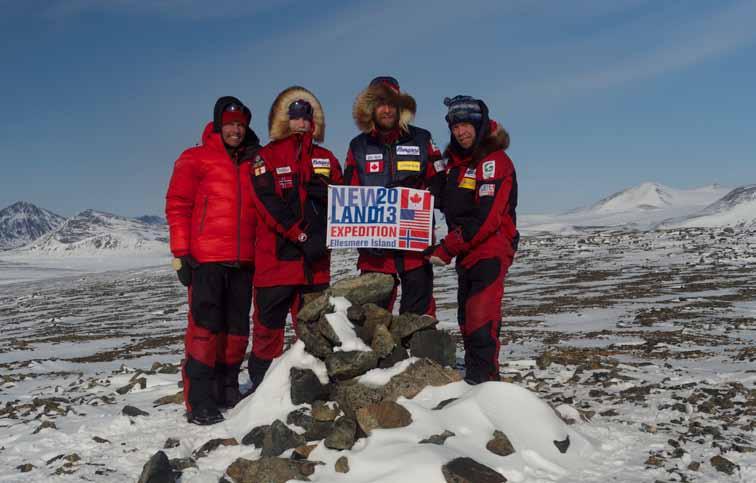
You can g et it if you really want There are ways to handle the money side of adventuring
Readers who enjoy yarns like the trek across Ellesmere Island might still end up thinking, “some guys have all the luck; I could never afford that kind of adventure.”
Well, we’re here to tell you that Hugh Dale-Harris and his family are no millionaires. They live frugally – bike everywhere, few restaurant meals, that kind of thing – and still go adventuring to the ends of the Earth.
As he says, “Financially we can pull this off partly because our family lives in a way that we don’t have a tonne of expenses. My current work is flexible, I’m an educational researcher with Lakehead University, and I work from home.”
But there’s more to it than that. You have to go looking for money, and Dale-Harris has done a lot of that, successfully.
It means finding sponsors. “Bergan’s of Norway and Devold saw something of value in this expedition, and without their financial and in-kind support, it would not happen,” Dale-Harris says.
“There were also a slew of sponsors providing free or at-cost gear including Oakley, Asnes, DeLorme, Brunton, Victorinox, MSR, Thermarest, Steger Mukluks, Granite Gear, GoPro, etc. who are interested in being involved in this kind of expedition.” They get publicity, gear-testing and testimonials in return.
The biggest expense is travel, Dale-Harris says. “We shared flights in and out with other expeditions, we looked at timing of shipments, methods of travel, every angle to save a buck. We opted for skijoring instead of dog teams partly because it meant using one Twin Otter charter instead of two, cutting that portion of air travel in half … [and] we accepted from the outset that none of us would be making any money directly from being on this expedition.”
How can readers do this themselves? “Do what you do, but do it a bit bigger. Email me hughdaleharris@gmail.com and I would be happy to consult … I am looking to advise people on going on bigger trips, to take that next step. Whether locally, or on trip like up to the Arctic.
“Start small, dream big.”








